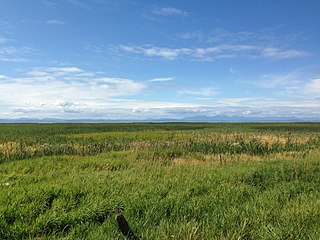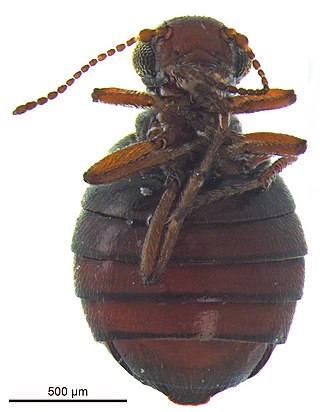
Vancouver Island is an island in the northeastern Pacific Ocean and part of the Canadian province of British Columbia. The island is 456 km (283 mi) in length, 100 km (62 mi) in width at its widest point, and 32,100 km2 (12,400 sq mi) in total area, while 31,285 km2 (12,079 sq mi) are of land. The island is the largest by area and the most populous along the west coasts of the Americas.

Vancouver Island University is a Canadian public university serving Vancouver Island and coastal British Columbia. Malaspina College began in 1969 and it has grown into a university which plays an important role in the educational, cultural, and economic life of the region. The main campus is located in Nanaimo; there are regional campuses in Duncan and Powell River as well as a centre in Parksville.

Mecoptera is an order of insects in the superorder Endopterygota with about six hundred species in nine families worldwide. Mecopterans are sometimes called scorpionflies after their largest family, Panorpidae, in which the males have enlarged genitals raised over the body that look similar to the stingers of scorpions, and long beaklike rostra. The Bittacidae, or hangingflies, are another prominent family and are known for their elaborate mating rituals, in which females choose mates based on the quality of gift prey offered to them by the males. A smaller group is the snow scorpionflies, family Boreidae, adults of which are sometimes seen walking on snowfields. In contrast, the majority of species in the order inhabit moist environments in tropical locations.

Euchloe ausonides insulanus, the island marble butterfly, is a subspecies of the Euchloe ausonides and is found in the San Juan Islands in Washington in the northwestern United States. The butterfly was thought to be extinct and was last observed on Gabriola Island, British Columbia in 1908. The species was rediscovered during a prairie butterfly survey in San Juan Island National Historical Park in 1998. After this rediscovery, surveys were conducted throughout the presumed range and found a few populations on San Juan Island and Lopez Island, but no remaining populations in Canada.
Apteropanorpidae is a family of wingless scorpionflies containing a single genus, Apteropanorpa, with four named species. These species, also called Tasmanian snow scorpionflies, are found in moss in Tasmania and southern Australia. The adults are generalised predators. The larvae live in moss and are locally common.

Boreidae, commonly called snow scorpionflies, or in the British Isles, snow fleas are a very small family of scorpionflies, containing only around 30 species, all of which are boreal or high-altitude species in the Northern Hemisphere.

Hypogastrura nivicola is a species of dark blue springtail. Its (US) English name is snow flea, but there are also insects called by that name. They are often seen jumping about on the surface of snow on a warm winter day in North America.

The Alaksen National Wildlife Area is located on Westham Island in the city of Delta, British Columbia. It is an important stopover point for many species of birds migrating along the Pacific Flyway.
Snow flea is a common name for several arthropods, not including true fleas:

Boreus is the most diverse of three genera of insects in the family Boreidae. They are commonly known as winter scorpionflies due to their close relation to the true scorpionflies and preference for cold habitats.

Boreus brumalis, the mid-winter boreu, is a species of snow scorpionfly in the family Boreidae. It is found in North America.
Boreus nix is a species of snow scorpionfly in the family Boreidae. It is found in North America.
Boreus californicus is a species of snow scorpionfly in the family Boreidae. It is found in North America.
Caurinus dectes is a species of snow scorpionfly in the family Boreidae. It is found in North America.

Caurinus is a genus of snow scorpionflies in the family Boreidae. There are at least two described species in Caurinus.
Boreus elegans is a species of snow scorpionfly in the family Boreidae. It is found in North America.
Valenzuela boreus is a species of lizard barklouse in the family Caeciliusidae. It is found in North America.
Apterobittacus is a genus of hangingflies in the family Bittacidae. There is one described species in Apterobittacus, A. apterus.
Boreus nivoriundus, known generally as the snow-born boreus or snow scorpionfly, is a species of snow scorpionfly in the family Boreidae. It is found in North America.
Boreus coloradensis is a species of snow scorpionfly in the family Boreidae. It is found in North America.









